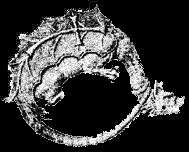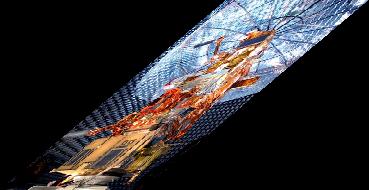Wednesday, 6. September 2006
Rabbi Hanina ben Dosa versus Awards(Reptilian-Snakes)
ats, 17:33h
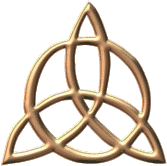
_____________________________________________
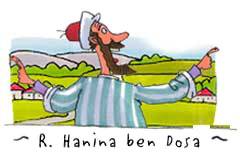 Hanina Ben Dosa was a first-century tanna (rabbinic teacher quoted in the Mishna) who lived in the lower Galilee and was a disciple-colleague of Yohanan b. Zakkai. Hanina was distinguished for his extreme piety, and for his zealous observance of religious precepts.
Hanina Ben Dosa was a first-century tanna (rabbinic teacher quoted in the Mishna) who lived in the lower Galilee and was a disciple-colleague of Yohanan b. Zakkai. Hanina was distinguished for his extreme piety, and for his zealous observance of religious precepts. The sages applied to him the Biblical phrase "man of truth" and held him up as an example of a completely righteous man.Because of his righteousness, his prayers were regarded as being especially acceptable and potent, and as a result he was frequently requested to pray for the sick and those in trouble. The aggadah speaks extensively of the miracles that happened for him; in fact, more has been transmitted about his pious deeds and his wonders than about his religious rulings and dicta.
It was said that "when Hanina b. Dosa died, men of deeds ceased and piety came to an end."
Of his wife, too, it was said that she resembled her husband in piety and like him was "accustomed to miracles."The following are selected tales from rabbinic literature about Hanina Ben Dosa's miracles. Enjoy and be inspired.
The Saint
&
the Serpent(s)
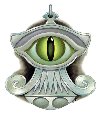
(Reptilian-snakes,Skull&Bones;Hegel,Herzl,Goethe;
Dr.Mengele-criminal nazi,...)

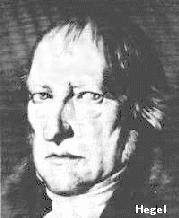
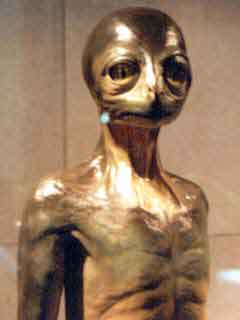

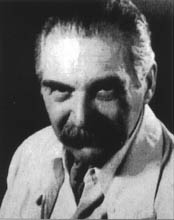
____________________________________
(Photo about Dr.Mengele is from Dr.Rath Foundation_
Education Services!!!)
______________________________________
Our rabbis taught:
It happened somewhere there was a serpent who hurt creatures.
They came and informed Rabbi Hanina ben Dossa.
He told them:
--"Point me to its hole."
When they did, he put his heel over the hole's mouth.
The serpent came out, bit him and died.
He hung it over his shoulder and brought it to the house of study.
He told them:
--"See, my sons! It is not the serpent that kills. Only sin kills."
With this they began to say:
--"Woe to the man who meets a serpent, but woe to the serpent who meets R. Hanina ben Dossa."
--- Babylonian Talmud, Berakoth 33a
by Reciting the 18 Benedictions
___ Let no one stand for the Prayer (Tephilla) without bowing his head.
The first chasidim used to wait for one hour and then pray,
so they could direct their hearts to the Place (Maqom).
Even if the king greets you with his "peace" (Shalom), do not answer him.
And even if a snake is coiled at your heel, do not break it off.
--- Mishna, Berakoth 5.1
Rabbi Hanina ben Dosa
The following is told about Rabbi Hanina ben Dosa who lived in the first century:
Once Rabbi Hanina ben Dosa went to immerse himself in [the water of] a cave. Kuthim (Samaritans) came and placed a large rock over the mouth of the cave. The spirits came and removed it. Subsequently, an evil spirit haunted a poor woman in Rabbi Hanina's neighborhood.
His students said to him: Rabbi, see how this poor woman suffers grief from the evil spirit.
Rabbi Hanina addressed the spirit: Why do you cause grief to the daughter of Abraham ?
The spirit responded: Are you not the one who went down to dip in the cave, and so on, ...till I came with my brothers and my father's household and removed the rock. Is this how you pay me for the favor I did you ?
He answered her: I decree...15
In spite of the abbridged nature of the story, it probably ended with Rabbi Hanina ordering the spirit to leave the poor woman, notwithstanding that previously the spirit (and its family) had done him a favor. Indeed the spirit fled and the woman was cured, revealing the power of Rabbi Hanina. It is to be noted that this story is not known from Talmudic literature itself but from the writing of a twelfth-century Ashkenazi wise sage. The question arises: is this a rabbinic text from the Talmudic period that for some reason, intentional or not, is unknown from Talmudic literature or a pseudoepigraphic text (invented centuries after the period to which it is attributed and intended to glorify the Talmudicsages). First it has to be noted that the fact that the cited text is known only from medieval times does not necessarily show that it is fabricated. This phenomenon - an ancient original text preserved only in the manuscript from a later corpus - is also known from other examples, such as the preservation of Sifri Zuta in Yalkut Shimoni and remnants of sermons of the Tannaim (Mishnaic rabbis) in the Great Midrash.16
Indeed the text itself shows signs of abridgement by the copier ('and so on', 'till I came') and the end is missing. It is possible that it was intentionally censored from a Talmudic text because of its blunt magic character. The fact that the Jerusalem Talmud, and also various midrashic (sermonic) texts, have not been preserved intact shows that it is definitely possible that this text is authentic and was originally written in the Talmudic period.
Indeed, lately it has been pointed out that the words of Rabbi Hanina to the spirit 'Why do you cause grief to the daughter of Abraham ?' are similar in content to the words of Jesus who cured a woman on the Sabbath (Luke 13, 16), as both incidents refer to 'daughter of Abraham'.17 This parallelism strengthens the conjecture that this text, known from a later source, is authentic.18
However, even if we claim that the text is from a Talmudic source, we have to clarify whether its source is an authentic tradition and whether Rabbi Hanina indeed accomplished what is attributed to him: exorcism. The answer is that in this matter there is considerable correspondence between this 'external' tradition about Rabbi Hanina and the other Talmudic traditions dealing with this personality.
It is told of Rabbi Hanina that he cured the sick with his prayer, including among others the son of Rabbi Yochanan ben Zakai; he lived for a week on a measure of carobs and a heavenly voice announced this and also that the world is sustained because of his merit; angels appeared to him in the form of humans; he denied that he was a prophet; as a consequence of his prayer the rain stopped and after a second prayer it began raining again; a miracle occurred to his wife and her oven filled wlith bread; a snake that bit him died; a miracle happened to him and vinegar burned as if it were oil; and so did various other miracles happened to him.19 It is indeed clear that his piety and righteousness exceeded his learning and his principal power was in being a miracle man recognized by all for his supernatural power, that is, divine.
Not only does everything said to this point match the 'external' tradition, but the Gemara in Pesahim 112, p. 2, cites an additional story more similar to the story considered here:
We have learned: One should not go out alone at night either the nights of the fourth year or the seventh because (the spirit) Agrath daughter of Mahlath, she and 180,000 angels of destruction go forth and each has permission to destroy on his own.
Originally they were present all the time. Once she encountered Rabbi Hanina. She said: If they had not announced about you in Heaven 'Be careful with Hanina and his learning' I would endanger you !
He said: If I have status in Heaven, I decree that you shall not pass through populated areas forever!
She said: With your permission, leave me a little opening. He left her the nights of the seventh and fourth years.
Here is the dialogue between Rabbi Hanina and the 'queen of the spirits',20 and the main thing: Rabbi Hanina disposed of her with the words 'I decree that you shall not pass through populated areas forever !', very similar to the words in shortened version of chasing away: 'I decree (that you should leave this woman !)'; an equivalent decree.
One can then say, if there is a Talmudic wise man to whom a story (belated, as it might be) of exorcism from a woman can be attributed, Rabbi Hanina was a personality suitable for it. Thus is the authenticity strengthened for this post-Talmudic story, similar in nature to additional Talmudic stories about exorcism.

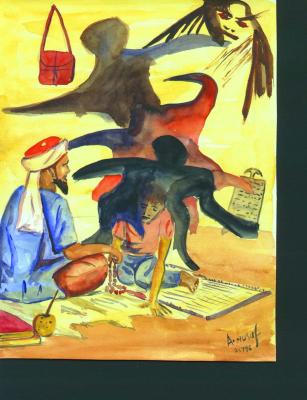
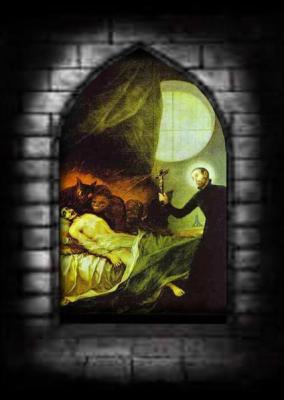 by real exorcists
by real exorcistsRabbi Chaninah ben Dosa says: All those whose fear of sin takes priority over his wisdom, his wisdom endures; And all those who prioritize wisdom over fear of sin, their wisdom does not endure.
He (further) used to say: One with which the spirit of his fellows is pleased with, the spirit of Hashem is (also) pleased with him. (Avot 3:11-12)
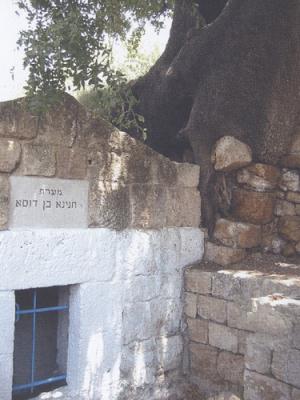
OTHER STORY(miracle)
The Lion and The Man
In the Coptic text, this saying actually ends "and the lion becomes man." While we have a Greek version of this, from the Oxyrhynchus papyri, the Greek version is too fragmentary to be of any use in determining the correct ending: scholars have to use the Coptic version to reconstruct the Greek. In my translation, I have reversed the ending to read "and the man becomes lion", as did Guillamont, Puech, Quispel et al, the first translators of the Gospel of Thomas. The reversed ending makes sense and most commentators agree that the corrected version is what was intended. Otherwise saying 7 requires particularly contorted interpretations. Richard Valantasis manages to have it both ways, and decides that the Greek version ends as my version does, while the Coptic version intentionally reversed it. In its modified form, the structure of the saying resembles a story from the Talmud about Rabbi Hanina ben Dosa, "When Rabbi Hanina ben Dosa prayed, a poisonous reptile bit him, but he did not interrupt his prayer. They departed and found the same 'snake' dead at the opening of its hole. 'Woe to the man', they exclaimed, 'bitten by a snake, but woe to the snake which has bitten Rabbi Hanina ben Dosa.' A modern parallel might be, "Dog bites man, that's not news; man bites dog, now that's news." Still, the structure of Thomas 7 is rather more complicated than either of these. In interpreting saying 7, the most pressing question is not the structure, but what is meant by the lion? The Gospel of Thomas doesn't specifically tell us the answer to either, but we may think that the man represents the spirit, since saying 114 promises Mary that she will become a living spirit, like you males. What of the lion? The Gospel of Thomas doesn't tell us, so we need to look to other texts in the ancient world, to determine what lions may mean in them. The most obvious option is that the lion represents the passions, or passionate emotion. Marvin Meyer mentions the following passage from Plato as a clue to the meaning of the lion (which curiously has a concept of two into one also):- "An ideal image of the soul, like the composite creations of ancient mythology, such as the Chimera or Scylla or Cerberus, and there are many others in which two or more different natures are said to grow into one.... Then do you now model the form of a multitudinous, many-headed monster, having a ring of heads of all manner of beasts, tame and wild, which he is able to generate and metamorphose at will.... Suppose now that you make a second form as of a lion, and a third of a man, the second smaller than the first, and the third smaller than the second.... And now join them, and let the three grow into one.... Next fashion the outside of them into a single image, as of a man, so that he who is not able to look within, and sees only the outer hull, may believe the beast to be a single human creature.... And now, to him who maintains that it is profitable for the human creature to be unjust, and unprofitable to be just, let us reply that, if he be right, it is profitable for this creature to feast the multitudinous monster and strengthen the lion and the lion-like qualities, but to starve and weaken the man, who is consequently liable to be dragged about at the mercy of either of the other two; and he is not to attempt to familiarize or harmonize them with one another -- he ought rather to suffer them to fight and bite and devour one another.... To him the supporter of justice makes answer that he should ever so speak and act as to give the man within him in some way or other the most complete mastery over the entire human creature. He should watch over the many-headed monster like a good husbandman, fostering and cultivating the gentle qualities, and preventing the wild ones from growing; he should be making the lion-heart his ally, and in common care of them all should be uniting the several parts with one another and with himself. " Plato, Republic 588-589b excerpted. There is also an incidental reference to a lion in the Cratylus dialogue Soc. That is a tremendous class of names which you are disinterring; still, as I have put on the lion's skin, I must not be faint of heart... And, of course, in the myth of Er, also in the Republic, we have a lion, an ape and an eagle. Here in Plato, in both the Republic and Cratylus, the lion is connected to the heart. The lion is an element of the tetramorph, a creature made up of four other creatures, just as Plato describes a triple-natured creature. The best known examples of the tetramorph are from Ezekiel and Revelation, "And round the throne, on each side of the throne, are four living creatures, full of eyes in front and behind: the first living creature like a lion, the second living creature like an ox, the third living creature with the face of a man, and the fourth living creature like a flying eagle. And the four living creatures, each of them with six wings, are full of eyes all round and within, and day and night they never cease to sing, "Holy, holy, holy, is the Lord God Almighty, who was and is and is to come!" Revelation 4:6-8 There are actually two elements of this tetramorph in saying 7, the lion and the man-and, of course, both occur in Plato's composite creature. The book of Daniel, which describes four different kinds of composite beasts, makes an explicit connection between the lion and the heart. This first beast has three elements of the tetramorph. "Daniel spake and said, I saw in my vision by night, and, behold, the four winds of the heaven strove upon the great sea. And the four great beasts came up from the sea, diverse one from another. The first was like a lion, and had eagle's wings: I beheld till the wings thereof were plucked, and it was lifted up from the earth, and made stand upon the feet as a man, and a man's heart was given to it." Daniel 7:2-4 In Daniel, the lion is somehow transformed into a man, standing up like a man, with a man's heart, just as the lion in Thomas is transformed into a man by being eaten. The story of Samson and the lion offers a similar symbolism and meaning. Samson kills the lion, then marries Delilah, then sees the corpse of the lion, in which bees have nested, producing honey. He takes the honey and eats it. Again, the lion has been transformed, and is eaten: "out of the eater came what is eaten, and out of the strong came what is sweet." A lion motif is found in the story of Daniel in the lion's pit. In Daniel 6:17-25 the men who had accused Daniel are eaten by the lions, whereas Daniel survives because an angel stops the mouths of the lions. In the later addition to the story, which are part of the Bel and the Dragon story in the section of Daniel relegated to the Apocrypha, (Daniel 14:31-42), an angel takes the prophet Habakkuk by the hair to the lion pit where he gives his meal to Daniel and then is whisked off again by the angel. So again, although Daniel doesn't literally eat the lions, he is given food by an angel while he is in with the lions, in contrast to the men who are eaten by the lions. It's not quite the same the as eating a lion is some form or other, but I suspect that the imagery is connected. To sum up, the likeliest meaning for the lion logion seven in the Gospel of Thomas is the heart, or the emotions, particularly the passionate or extreme emotions, which should be consumed, in the manner of Samson consuming the honey found in the lion's corpse, or transformed, into a man, or what is male within one, to receive the spirit.( see also Psalm de ORDO equestris Draconis in Hungaria)...
